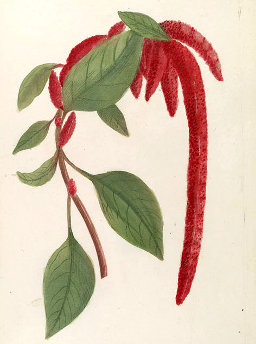 Amaranthus caudatus
Amaranthus caudatus
Love-Lies-Bleeding
This old-time garden plant
was introduced to Europe from the Andes in the 16th century. In
the New World, it was not a simple decoration. The Aztecs grew this
magic herb as part of their honoring of Huitzilopochtli, god
of war and the sun and a great magician. During his festival month,
a statue was made in his honor of amaranth seeds bound with honey.
At the end of the festival, the statue was cut up and distributed to the
people to be eaten. The Spanish conquerors of Mexico outlawed the
cultivation of this plant because of its connection to pagan worship. The Hopi
still produce a ceremonial dye from its flowers. In West European
tradition, love-lies-bleeding is more commonly considered a funerary
plant, probably because of the drooping flowers; perhaps that's
why it became a favorite in Victorian gardens, which had more than
a little goth flavor. Consider love-lies-bleeding a Mars herb useful
for magical protection
and attack magic. This plant
is also known as nun's scourge(!), red-hot cattail, Inca wheat,
African spinach, fox tail, and tassel flower (although there is
a whole 'nother plant, Emilia javanica, also known as tassel flower).
Mundane Uses
The high-protein seeds are used as a grain in many areas, including both some Andean and equatorial
African countries. They are usually popped and then ground.
And they are numerous: a single plant can make 50,000 of them. To make a leavened bread, the seeds have to be mixed
with wheat (they have no gluten). In Ethiopia, the seeds are fermented
to make a beer. They can also be sprouted, and the leaves are edible.
What is left at the end of the season is often fed to livestock
and the stems used in thatch. All in all, a very useful plant. This
particular variety, though, has been developed specifically for
large, striking flowers.
How to Grow Love-Lies-Bleeding
Start transplants 4-6 weeks before your last frost or sow seeds directly in
the garden after danger of frost has passed; it can be grown in
large containers. Barely cover the seeds to germinate in 1-2 weeks
at 70-75F/21-24C. Love-lies-bleeding grows 3-4ft/90-120cm tall. Space 12-15"/30-40cm apart in
full sun. Blooms mid-summer through fall. Amaranth grows especially
well at high elevations under intense sun but cool, dry conditions.
It doesn't like high humidity. Harvest for fresh flowers when 3/4s
of the flowers on a spike are open. Harvest for drying when the
seeds are starting to set and the spikes feel a little stiff.
General
growing info
Amaranthus caudatus
Love-Lies-Bleeding
100 seeds $3.75
Uses in Witchcraft & Magic:
Protection
Mars Herb
© 2011-2024 Alchemy Works; No reproduction without permission